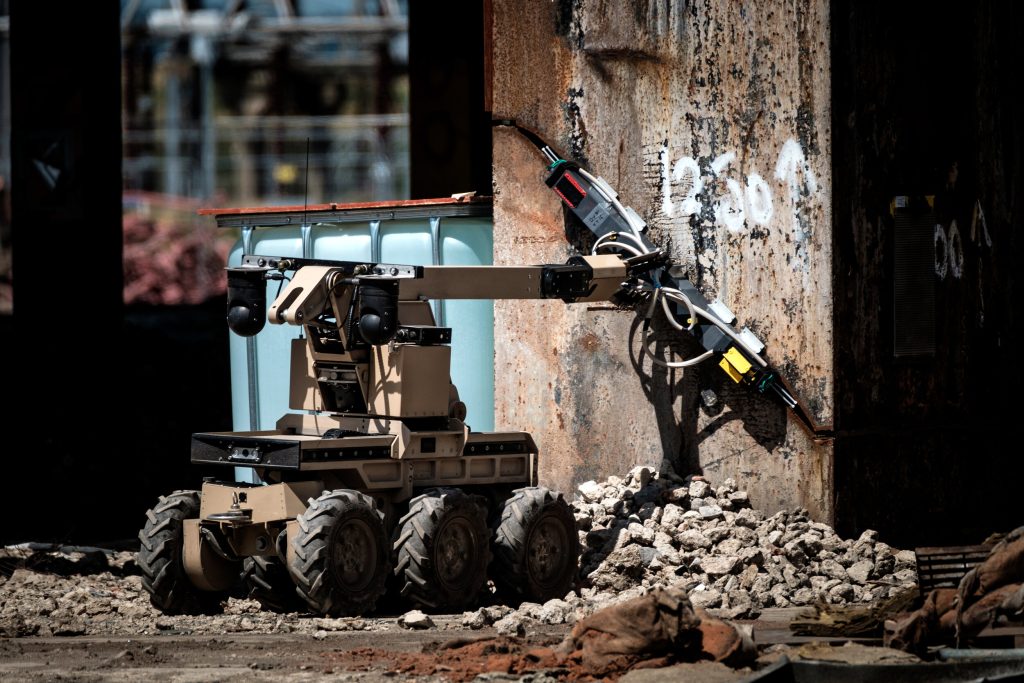Explosive Charge
Explosive material or substance designed to detonate upon activation, typically composed of a chemical mixture that rapidly releases gasses and heat, resulting in a sudden and intense expansion of pressure, often accompanied by heat, light, sound, and the release of debris.
Explosive Load
The quantity or amount of explosive material in a device, container, or area. The measure of the explosive power or potential contained within the explosives.
Explosive Method of Entry (EMoE)
Law enforcement, military, and specialised security personnel use EMoE techniques to enter secured or barricaded structures or vehicles. In EMoE operations, trained personnel use precisely placed explosives to breach doors, windows, walls, or other barriers obstructing entry. The explosives are strategically deployed to create a controlled breach, allowing entry into the target location while minimising collateral damage and ensuring the safety of the team and any individuals inside the structure.
Explosive Ordnance (EO)
Munitions, devices, or materials designed to explode, detonate, or produce an explosive effect, including types of weapons, ammunition, explosives, and related components. Examples of explosive ordnance include grenades, bombs, mines, artillery shells, rockets, and improvised explosive devices (IEDs).
Explosive Ordnance Disposal (EOD)
Explosive Ordnance Disposal (EOD) refers to the specialised process of identifying, rendering safe, recovering, and disposing of explosive threats on land and underwater. These threats include unexploded ordnance (UXO), improvised explosive devices (IEDs), and hazardous munitions. EOD technicians are trained professionals who use advanced tools, technologies, and techniques to mitigate risks associated with these threats, ensuring the safety of personnel, infrastructure, and the environment.
EOD operations are integral to military and civilian sectors, with applications spanning battlefield clearance, public safety, humanitarian demining, and emergency response. These operations often involve the deployment of robotics, including Remotely Operated Vehicles (ROVs), for safe remote handling, particularly in high-risk or hard-to-access areas.
Explosive Remnants of War (ERW)
Explosive devices that remain in a post-conflict area after the cessation of hostilities. These remnants pose a threat to civilians and can cause death, injury, and property damage. ERW encompass a variety of explosive items, including unexploded ordnance (UXO), abandoned explosive ordnance (AXO), and other explosive hazards such as improvised explosive devices (IEDs) and booby traps.
Explosive Trace Detection (ETD)
Explosive Trace Detection uses technology to detect microscopic traces of explosives on surfaces, clothing, or other items.
Explosive Train
An explosive train comprises a series of explosive components arranged sequentially, each with a specific function. These components typically include a primary initiator (e.g., a detonator), an intermediate booster charge, and a main explosive charge. The sequence ensures a reliable and controlled transition from a small initial stimulus to a large, powerful explosion.
Explosively Formed Projectile (EFP)
EFPs are a type of munition for penetrating armour, hardened targets, bunkers, and other fortified structures. They use an explosive charge to form and propel a high-speed projectile. Unlike traditional shaped charges that focus their explosive energy into a directed metal jet, EFPs use a concave metal liner that deforms upon detonation, shaping into a projectile that travels at high velocity towards the target.
Explosives
Explosives are substances that, when subjected to an external stimulus (e.g., heat, shock, friction), undergo a rapid, self-sustaining exothermic reaction, producing large volumes of gas, heat, and pressure in a short period. Depending on the material and conditions, this reaction can be either a deflagration or a detonation.
Explosives Engineering
Explosives Engineering is a specialised field of engineering that focuses on the design, development, testing, and application of explosive materials and devices. It is a discipline that requires understanding the principles of explosive chemistry, physics, and mechanics to harness the energy released by explosives safely and effectively for specific applications. Explosives engineers work in diverse industries, including mining, construction, demolition, military, and law enforcement.
Explosive engineering demands a solid foundation in maths, physics, chemistry, engineering principles, and specialised knowledge of explosives and their behaviour. Professionals in this field must adhere to strict safety protocols and regulations to minimise the risk of accidents and protect personnel, property, and the environmen
Explosives Management
Explosives management involves the systematic handling, storage, transportation, and disposal of explosive materials to ensure safety, security, and regulatory compliance. It involves protocols, procedures, and technologies to minimise the risks associated with explosives, such as accidental detonations, unauthorised access, theft, or diversion for illicit purposes. Effective explosives management typically includes measures for risk assessment, training, monitoring, and enforcement of relevant laws and regulations to safeguard people, property, and the environment.
Firing Circuit
The electrical circuit used to initiate the detonation sequence.
High Explosives
High Explosives are a class of explosive materials characterised by rapid and violent decomposition, resulting in supersonic shockwave propagation. Compared to low explosives, high explosives undergo a detonation process in which the chemical reaction occurs at speeds faster than the speed of sound. This rapid reaction releases tremendous energy in a fraction of a second, producing a powerful shockwave, heat, light, and gas expansion. Common examples of high explosives include TNT (trinitrotoluene), RDX (cyclo trimethylene trinitramine), PETN (pentaerythritol tetranitrate), and HMX (cyclo tetramethylene tetra nitramine). Due to their highly reactive nature, high explosives require careful handling, storage, and expertise to ensure safety and effective use.
Homemade Explosives (HME)
An HME is an explosive material made using commonly available or improvised ingredients. It is typically produced by individuals or small groups using simple methods and equipment, often without formal training or expertise in explosives chemistry.
HMEs are made from various substances, including household chemicals, agricultural fertilisers, industrial solvents, and other readily available materials. These substances are often mixed and processed to create a volatile explosive compound. Due to their improvised nature, HMEs vary widely in composition, potency, and stability. Their potential for accidental detonation or unintended consequences may pose significant safety risks to the individuals manufacturing them and others in the vicinity.
Humanitarian Mine Action (HMA)
HMA addresses the humanitarian impact of landmines, unexploded ordnance (UXO), and other explosive remnants of war (ERW). Humanitarian Mine Action encompasses a range of efforts focused on mitigating the threat posed by these explosive hazards and assisting affected communities in their clearance, risk education, victim assistance, and advocacy efforts. HMA plays a critical role in addressing the humanitarian consequences of landmines, UXO, and ERW and in contributing to peacebuilding, development, and the protection of human rights in affected communities.
Improvised Explosive Device (IED)
A homemade explosive device constructed and deployed in a non-conventional manner, IEDs are created using readily available materials, such as explosives, triggering mechanisms (such as timers, remote controls, or pressure plates), and containers (such as pipes, cans, or vehicles) to conceal and deliver the explosive charge. Often used by insurgent groups, terrorists, or other non-state actors in asymmetrical warfare, terrorism, or guerrilla tactics, IEDs pose a significant threat to military personnel, civilians, and infrastructure, as they can be easily concealed, deployed remotely, and targeted at specific locations or individuals.
Improvised Explosive Device Disposal (IEDD)
IEDD is the specialised field of operations dedicated to the detection, neutralisation, and disposal of improvised explosive devices (IEDs). IEDD operators are highly trained personnel, often military or law enforcement professionals, possessing expertise in explosives, bomb disposal techniques, and advanced detection technologies. Their primary objective is to safely locate, assess, and render safe improvised explosive devices to minimise the risk of harm to civilians, military personnel, or infrastructure. IEDDs play a crucial role in counter-terrorism efforts and in mitigating the threat posed by IEDs in conflict zones, urban areas, and other environments where hostile actors may employ these devices.
International Mine Action Standards (IMAS)
International Mine Action Standards (IMAS) are a comprehensive body of technical and operational standards, guidelines, and procedures for the planning, managing, and implementing of mine action programmes. Developed by the United Nations Mine Action Service (UNMAS) and endorsed by the international mine action community, IMAS represent a consensus of best practices and provides a normative framework for all organisations involved in mine action. They cover various topics, including landmine and ERW surveys, marking, clearance and disposal, risk education, victim assistance, and quality management. IMAS are regularly reviewed and updated to reflect advances in technology and best practices, ensuring a consistent and professional approach to mine action worldwide.
Jet Forming Cone (JFC)
A Jet Forming Cone (JFC) is a precisely shaped liner, often constructed from a dense metal such as copper or magnesium, that is a key element in the Munroe effect within a shaped charge. Upon detonation, the cone collapses inward, transforming into a high-speed jet. Its geometry and material properties are carefully designed to ensure the controlled formation of this jet when subjected to the hydrodynamic forces of a detonation wave, for applications such as penetration or other specific purposes.
Jetting
Jetting is the directional force produced by the detonation of explosives.
Kilonewton
Kilonewton is a unit of force, equivalent to one thousand newtons, used to measure explosive force
Landmine
Landmines are explosive devices designed to be detonated by a person’s presence, proximity, or contact. Landmines are typically buried underground and can cause injury or death to civilians long after a conflict has ended.
Linear Cutting Charge
A Linear Cutting Charge is an explosive device that produces a focused, high-energy cutting action along a linear path. It typically consists of a shaped explosive charge within a flexible or semi-rigid housing, often incorporating a metal liner to enhance the cutting effect. Linear cutting charges enable controlled demolition, breaching, and other applications requiring precise and localised cutting.
Low Explosives
A class of explosive materials characterised by a slower rate of decomposition or combustion compared to high explosives. In low explosives, the chemical reaction occurs at a subsonic speed, resulting in a slower release of energy. This slower reaction makes low explosives suitable for applications where a sustained, controlled release of energy is required, such as in propellants for firearms, fireworks, or blasting agents for mining and construction. Low explosives are typically less sensitive to shock and friction than high explosives, making them safer to manage and transport.
Manual Demining
Handheld tools, such as metal detectors and probes, are used by qualified deminers to locate and safely remove landmines and UXO.
Mechanical Demining
Heavy machinery, such as flails, tillers, and excavators, is used to clear vegetation and unearth buried landmines and UXO.
Mine
A mine is a strategically placed, self-contained explosive device designed for area denial and to remain dormant until activated by various influence or contact triggers on land or in water. These triggers initiate a primary explosive charge, which then detonates the main explosive charge. Mines are typically deployed by hand, vehicle, or air, and pose a significant threat to personnel, vehicles, and vessels. Their long-term presence can have severe humanitarian and economic consequences, disrupting movement, and inflicting casualties.
Mine Action
Mine action is the coordinated efforts by governments, international organisations, and NGOs to address the threat of landmines and UXO through clearance, survey, risk education, victim assistance, and advocacy.
Mine Clearance
Mine clearance systematically locates, identifies, and neutralises landmines and UXO to render an area safe for civilian use.

